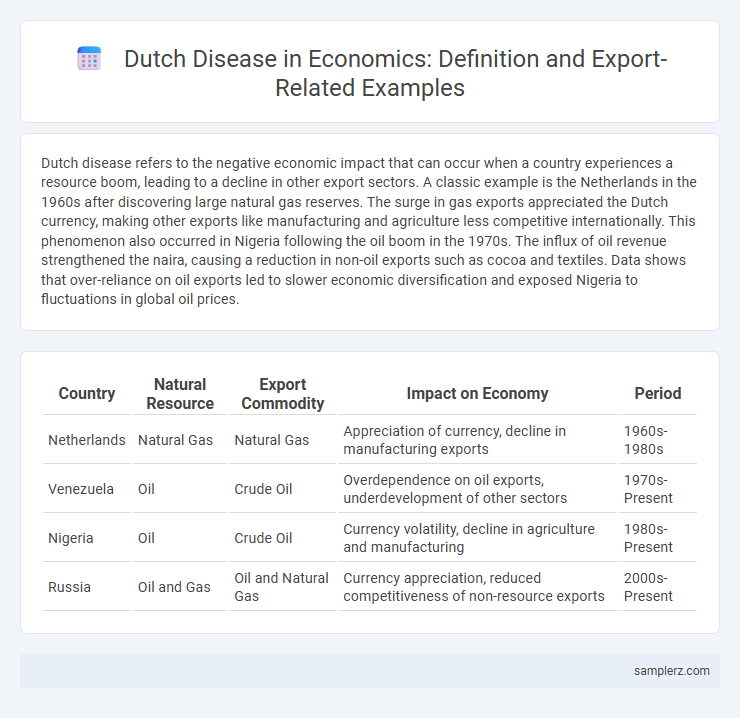Dutch disease refers to the negative economic impact that can occur when a country experiences a resource boom, leading to a decline in other export sectors. A classic example is the Netherlands in the 1960s after discovering large natural gas reserves. The surge in gas exports appreciated the Dutch currency, making other exports like manufacturing and agriculture less competitive internationally. This phenomenon also occurred in Nigeria following the oil boom in the 1970s. The influx of oil revenue strengthened the naira, causing a reduction in non-oil exports such as cocoa and textiles. Data shows that over-reliance on oil exports led to slower economic diversification and exposed Nigeria to fluctuations in global oil prices.
Table of Comparison
| Country | Natural Resource | Export Commodity | Impact on Economy | Period |
|---|---|---|---|---|
| Netherlands | Natural Gas | Natural Gas | Appreciation of currency, decline in manufacturing exports | 1960s-1980s |
| Venezuela | Oil | Crude Oil | Overdependence on oil exports, underdevelopment of other sectors | 1970s-Present |
| Nigeria | Oil | Crude Oil | Currency volatility, decline in agriculture and manufacturing | 1980s-Present |
| Russia | Oil and Gas | Oil and Natural Gas | Currency appreciation, reduced competitiveness of non-resource exports | 2000s-Present |
Understanding Dutch Disease in the Export Sector
Dutch Disease occurs when a country's booming export sector, often driven by natural resource discoveries like oil or minerals, leads to currency appreciation that undermines competitiveness in other export industries. This phenomenon causes a shift of labor and capital towards the resource sector, reducing manufacturing and agricultural exports. Examples include Nigeria's oil boom, which appreciated the naira and hurt its agricultural exports, illustrating how Dutch Disease distorts economic diversification and export performance.
Classic Examples of Dutch Disease: Export-Fueled Economies
Classic examples of Dutch disease occur in countries like Nigeria and Venezuela, where heavy reliance on oil exports caused currency appreciation, leading to a decline in manufacturing and agricultural exports. This economic imbalance results from the resource boom attracting capital and labor into the booming sector, reducing competitiveness in other export industries. The resulting export contraction harms overall economic diversification and long-term growth prospects.
The Oil Boom and Dutch Disease: Nigeria’s Export Challenges
Nigeria's oil boom created a significant increase in oil exports, which led to currency appreciation and a decline in competitiveness of non-oil sectors, exemplifying Dutch disease. The surge in oil revenues caused the Nigerian naira to strengthen, making agricultural and manufacturing exports less competitive internationally. This shift exacerbated Nigeria's export diversification challenges, limiting long-term economic growth and increasing dependence on volatile oil markets.
Dutch Disease in Russia: The Role of Natural Gas Exports
Russia's economy exhibits a classic case of Dutch Disease where natural gas exports significantly impact other sectors. The dominance of natural gas revenues leads to currency appreciation, making Russian manufactured goods less competitive on the global market. This economic dynamic results in reduced diversification and increased vulnerability to fluctuations in global energy prices.
Indonesia’s Resource Export Surge: A Case Study in Dutch Disease
Indonesia's recent surge in resource exports, particularly in palm oil, coal, and natural gas, exemplifies Dutch disease, where rapid revenue inflows from these sectors have led to currency appreciation and decline in manufacturing competitiveness. The strengthened rupiah reduces export competitiveness for non-resource goods, limiting industrial diversification and economic resilience. This resource dependence hampers Indonesia's long-term growth prospects by distorting labor allocation and investment away from higher value-added industries.
Venezuela’s Oil Exports and the Onset of Dutch Disease
Venezuela's heavy reliance on oil exports led to a classic case of Dutch disease, where the surge in oil revenues caused an appreciation of the real exchange rate, undermining the competitiveness of other export sectors like agriculture and manufacturing. This structural shift resulted in a decline of diversified economic activities, increasing vulnerability to oil price volatility. Consequently, the economy faced reduced export diversification and heightened exposure to external shocks, limiting sustainable growth prospects.
The Impact of Mining Exports on Mongolia’s Broader Economy
The surge in mining exports, particularly copper and gold, has led to an appreciation of Mongolia's currency, causing challenges for other export sectors like agriculture and manufacturing. This resource-driven export boom contributed to inflated domestic prices, reducing competitiveness and hindering economic diversification. Consequently, Mongolia's reliance on mining exports exposes the economy to volatile commodity prices, amplifying risks associated with the Dutch disease phenomenon.
Export-Driven Currency Appreciation: The Australian Experience
Australia's experience with export-driven currency appreciation illustrates a classic case of Dutch disease, where booming commodity exports, particularly in minerals and energy, have led to a significant appreciation of the Australian dollar. This currency strength undermines the competitiveness of non-mineral export sectors like manufacturing and agriculture by making their goods more expensive on the global market. As a result, Australia faces challenges in diversifying its economy while managing the economic imbalances caused by resource-driven currency appreciation.
Dutch Disease Manifestations in Canada’s Energy Exports
Canada's energy exports, especially in oil and gas sectors, illustrate Dutch Disease by causing currency appreciation that undermines the competitiveness of other export industries such as manufacturing and agriculture. The significant rise in energy revenues leads to capital inflows and higher exchange rates, resulting in decreased exports in non-energy sectors. This economic phenomenon highlights the trade-offs between natural resource booms and broader export diversification challenges.
Preventing Dutch Disease: Lessons from Norway’s Export Strategy
Norway successfully prevented Dutch Disease by leveraging its sovereign wealth fund to stabilize the economy and avoid excessive currency appreciation from oil exports. The government invested oil revenues abroad, maintaining competitiveness in non-oil sectors like fisheries and manufacturing. This strategic fiscal management preserved export diversification and long-term economic stability.

example of Dutch disease in export Infographic
 samplerz.com
samplerz.com